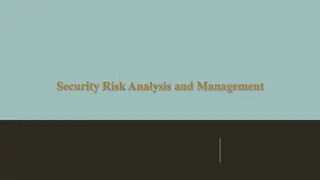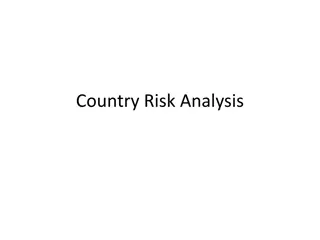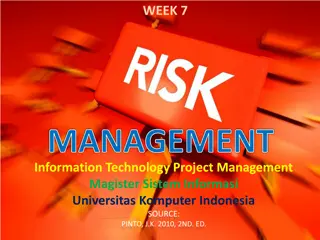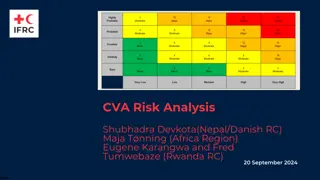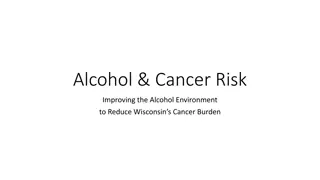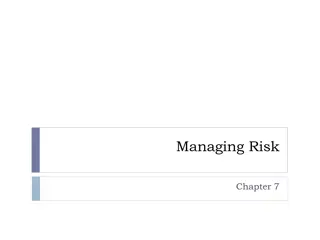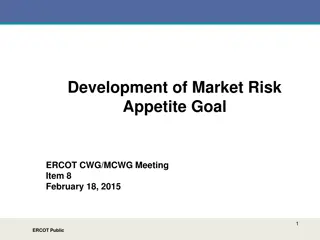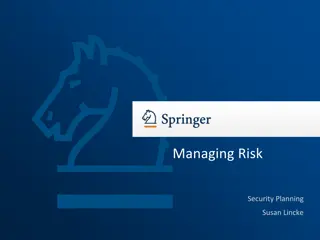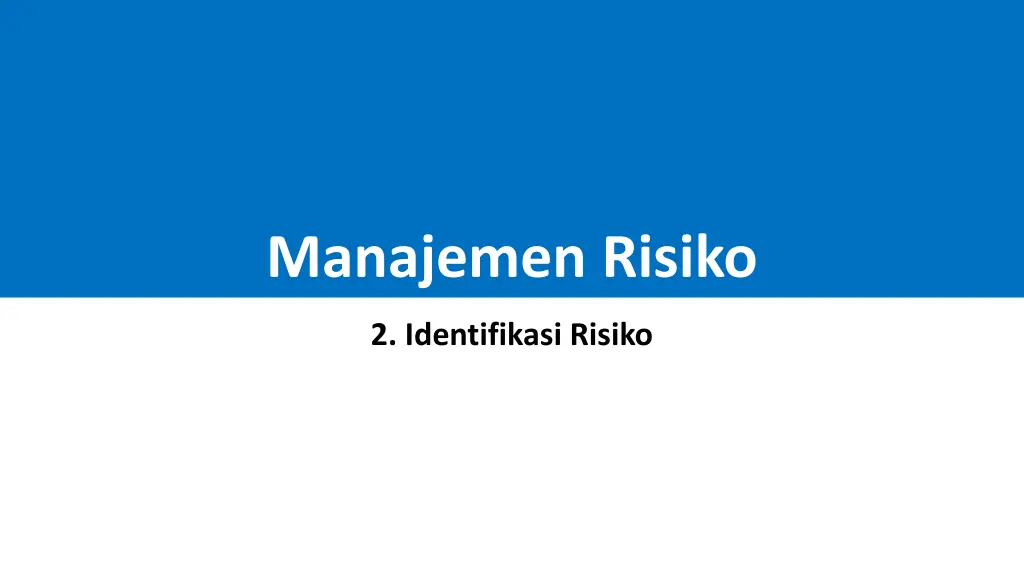
Risk Management Process and Identifying Project Risks
Learn about risk management, the process of identifying, analyzing, and responding to project risks to maximize positive outcomes and minimize adverse events. Explore the objectives of risk identification, characteristics of risks, and comparison of risk management processes. Understand the continuous risk identification process and different types of risks that could impact a project.
Download Presentation

Please find below an Image/Link to download the presentation.
The content on the website is provided AS IS for your information and personal use only. It may not be sold, licensed, or shared on other websites without obtaining consent from the author. If you encounter any issues during the download, it is possible that the publisher has removed the file from their server.
You are allowed to download the files provided on this website for personal or commercial use, subject to the condition that they are used lawfully. All files are the property of their respective owners.
The content on the website is provided AS IS for your information and personal use only. It may not be sold, licensed, or shared on other websites without obtaining consent from the author.
E N D
Presentation Transcript
Manajemen Risiko 2. Identifikasi Risiko
Definisi The PMI PMBOK defines risk management as the systematic process of identifying, analyzing, and responding to project risks . The concept aims at maximizing the probability and consequences of positive events and minimizing the probability and consequences of adverse events to project objectives.
Perbandingan Proses Manajemen Risiko PMBOK dengan yang lain Ket: Risk Management Standard AS/NZSA4360:2004 (Australia) Project Risk Analysis and Management PRAM (UK) Risk Management PMBOK (USA)
Objectives of Risk Identification 1. Identify and categorize risks that could affect the project 2. Document the risks
Risk Identification Process Identification processes begin with an examination of issues and concerns created by the project development team. These issues and concerns can be derived from an examination of the project description, work breakdown structure, cost estimate, design and construction schedule, procurement plan, or general checklists. Risks are those events that team members determine would adversely affect the project. Risk identification is continuous and new risks should continuously be invited into the process.
Risk Characteristics (1) 1. Knowns, known-unknowns, unknown-unknowns. 2. Risk triggers. 3. Risk versus opportunity events.
Risk Characteristics (2) 1. Knowns, known-unknowns, unknown-unknowns. A known is an item or situation containing no uncertainty. Known-Unknowns are things we know but we do not know how they will affect us A unknown-unknown is simply an item or situation whose existence has yet to be encountered or imagined.
Unknown unknowns sumber risiko dalam proyek konstruksi infrastruktur Manajemen risiko: meningkatkan probabilitas dan dampak dari events yang positif dan mengurangi probabilitas dan dampak dari events yang negatif. Risiko yang tidak teridentifikasi, tidak terbayangkan sebelumnya, atau unknown unknown biasanya berada di luar lingkup manajemen risiko. Istilah unknown unknowns dipopulerkan oleh Donald Rumsfeld pada tahun 2002. Sejak itu mulai digunakan quadrants of knowledge untuk memahami dan menjelaskan sifat risiko. Risiko diklasifikasikan berdasarkan tingkat pengetahuan (knowledge) mengenai terjadinya risk event (known atau unknown) dan tingkat pengetahuan mengenai dampaknya (known dan unknown).
Klasifikasi Risiko (Sumber: Veronika, A. (2020), Navigating Thru the Black Swan Event )
Quadrants of Knowledge untuk memahami risiko (Sumber: Veritas Total Solutions, CTRM Project Management Done Right)
Black Swans (Sumber: Veronika, A. (2020), Navigating Thru the Black Swan Event )
Evolution of Project Knowledge through Project Development WSDOT (2009)
Risk Characteristics (3) 2. Risk triggers, risk symptoms, warning signs Indications that a risk has occurred or is about to occur. Triggers may be discovered in the risk identification process and watched in the risk monitoring and updating process The identification and documentation of triggers early in the process can greatly help the risk management process.
Risk Characteristics (4) 3. Risk versus opportunity events It is often helpful to think of risk in broader terms of uncertainty. Uncertainty involves both positive and negative events. It is often helpful to separate uncertain events into those events that can have a negative effect (risks) and those that can have a positive effect (opportunities).
Identifikasi Risiko Faktor-faktor lingkungan perusahaan Inputs Tools & Techniques Documentation review Brainstorming Delphi method Interview Root cause identification SWOT Analisis Checklist Teknik diagram (cause effect, flow chart) Aset-aset proses organisasional Outputs Pernyataan lingkup proyek Risk register Rencana manajemen risiko Rencana manajemen proyek Perencanaan Manajemen Risiko Pengendalian dan Monitoring Risiko Perencanaan Respon Risiko Analisis Risiko Kualitatif Analisis Risiko Kuantitatif Identifikasi Risiko
Risk Identification Tools and Techniques Project-Specific Documents Programmatic Documents Techniques Project Description Historic data Brainstorming Work Breakdown Structure Checklists Scenario planning Cost estimate Final project reports Expert interviews Design & construction schedule Risk response plans Nominal group methods Procurement plan Organized lessons learned Delphi methods Listing of team s issues & concerns Published commercial databases Crawford slip methods Academic studies Influence or risk diagramming
Risk Sources (Factors) Classification RISK SOURCES/FACTORS EXTERNAL UNPREDICTABLE EXTERNAL PREDICTABLE INTERNAL NONTECHNICAL TECHNICAL LEGAL Market risks Operational Environmental impacts Social Inflation Changes in technology Performance Risk specific to technology Design Licenses Contractual Third-party suit Force majeure Management Schedule Cost Cash flow Regulatory Natural Hazards Postulated events (PMI - Adapted from Project an Risk Management: A Guide to Managing Project Risks, Wideman 1992)

